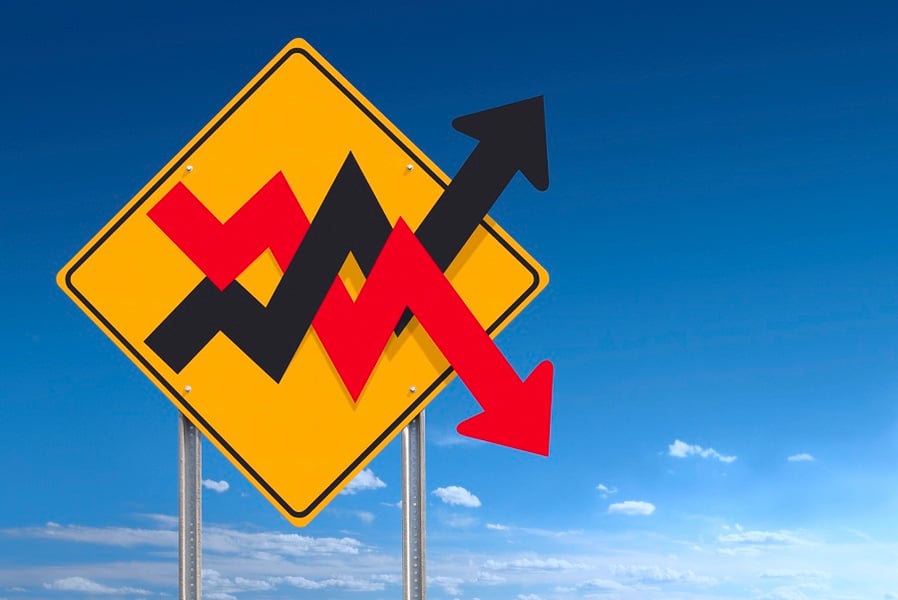

After weeks of stomach-churning volatility, Wall Street pundits are blaming a burgeoning leveraged investment strategy for exacerbating stock-market moves, particularly right before the end of the trading day.
Funds that use derivatives to offer juiced-up or inverse returns of individual companies and indexes sold about $15 billion of stocks on Sept. 3 — when the Nasdaq 100 plunged 3% — according to JPMorgan Chase & Co. That was the cohort’s biggest selling wave from rebalancing since the onset of the pandemic.
The activity also put pressure, per Nomura Holdings Inc., on S&P 500 futures, which tumbled 34 points to 5,516 in 17 minutes near the end of the trading session.
Last Tuesday wasn’t an anomaly. These days, leveraged ETFs may be exerting their biggest ever influence on the broader marketplace, according to Morgan Stanley’s quantitative and derivatives sales team, citing data starting from 2017 onwards. Specifically, for every 1% drop in share prices, these funds would now need to sell almost $7 billion of equities, or vice versa.
Given that leveraged and inverse ETFs are supposed to be held for short periods, they’re rebalanced near the market close every day to match their target performance. That’s leaving stocks susceptible to swings in either direction on volatile days, especially with assets in such ETFs ballooning to a record $117 billion this year.
While their transactions amount to a tiny fraction of the $600-billion-a-day stock market, the fact that all the activity is clustered near a short window means they can exert an outsize impact.
“Not only has the universe grown, but we have some of the big products getting more leverage, which creates more rebalancing flows,” said JPMorgan strategist Nikolaos Panigirtzoglou. “$10 billion to $15 billion rebalancing at the end of a day is not small.”
While critics argue that leveraged and inverse ETFs fan speculative trading, such funds have become popular among retail investors in recent years.
“Look at their assets effectively at all-time highs, then look at the larger market moves,” Charlie McElligott, a cross-asset strategist at Nomura, said about the universe of leveraged and inverse funds. “By definition, they’re simply going to have more to move on their mechanical end-of-day rebalancing.”
The likes of the $22 billion ProShares UltraPro QQQ (TQQQ) and the $11 billion Direxion Daily Semiconductors Bull 3x Shares (SOXL) are among the biggest and most actively traded leveraged products. TQQQ aims to deliver three times the return of the tech-heavy Nasdaq 100 Index while SOXL seeks to boost the returns of the NYSE Semiconductor Index to a similar degree. ProShares and Direxion declined to comment.
Leveraged products are back in the spotlight as traders try to keep up with a market that has been whipsawed by recession fears, uncertainty about the pace of the Federal Reserve’s rate cuts and dicey liquidity. The S&P 500 sank more than 8% over three weeks through early August before erasing almost all the losses. On Wednesday, the benchmark wiped out a 1.6% intraday decline to end the session 1% higher.
Of course, the impact of these funds — which trade within a vast market ecosystem – shouldn’t be overstated. Other factors, such as rebalancing from volatility-targeting strategies and the activity in zero-day options, can also amplify stock moves.
Still, the snowball effect from leveraged funds was notable on Sept. 3. Due to the concentration of those products in semiconductor and megacap tech stocks, the brunt of the selling last Tuesday hit those sectors, according to Nomura.
There’s no sign of applying brakes. There have already been a record 46 launches in leveraged and inverse ETFs this year. More broadly, efforts are afoot to further amp up the volatility of funds in this category.
Peter Tchir, head of macro strategy at Academy Securities, is among those to note the uptick in leveraged ETF activity. To him, the concentration of the year-to-date gains in only few names along with thin liquidity in the past few weeks have exacerbated the effect of those complex ETFs.
“Leveraged ETFs play a role both as a signal of froth, but also because the rebalancing tends to amplify moves,” Tchir said. “More people seem to be paying attention to those rebalancings.”

Former Northwestern Mutual advisors join firm for independence.

Executives from LPL Financial, Cresset Partners hired for key roles.

Geopolitical tension has been managed well by the markets.

December cut is still a possiblity.

Canada, China among nations to react to president-elect's comments.
Streamline your outreach with Aidentified's AI-driven solutions
This season’s market volatility: Positioning for rate relief, income growth and the AI rebound
